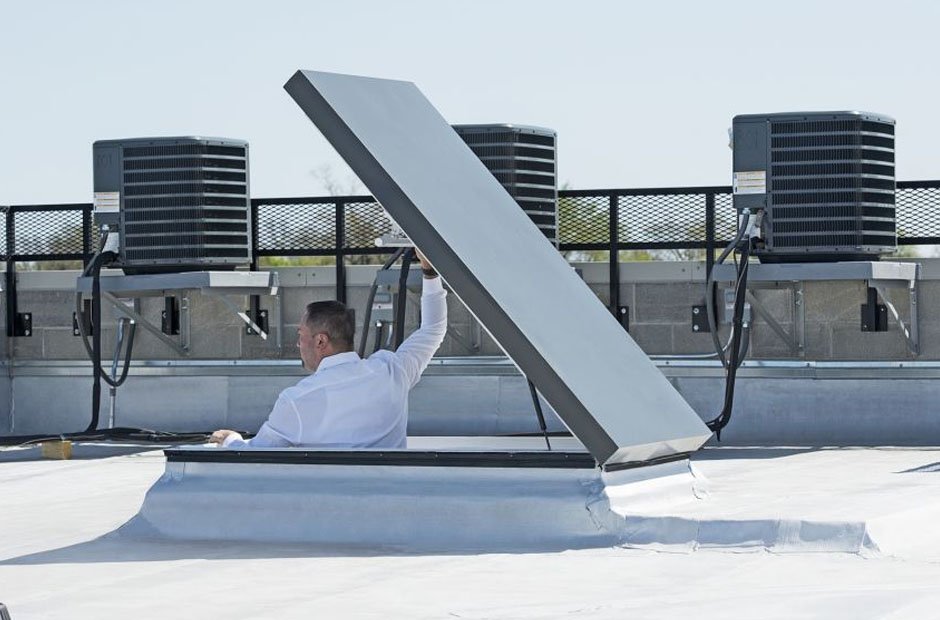As builders and designers, you understand the importance of creating functional and safe structures. Roofs, while vital for protection, also require occasional maintenance and inspections. This is where a roof access door comes in, essential to ensuring easy and secure access to the rooftop.
Why Do You Need a Roof Access Door?
Imagine inspecting a roof for storm damage or installing a new ventilation system. Reaching the rooftop would be risky and potentially damaging to the roof without a designated access point. Improvised methods, like walking on roof tiles or using ladders against walls, can cause unnecessary wear and tear—or worse, lead to slips and falls.
A properly installed roof access door provides safer and more convenient access to the rooftop for maintenance, repairs, or future installations. It eliminates the need for risky maneuvers and protects the roof’s integrity.
Roof Access Door Types: Choosing the Right Fit
Now that we’ve established the importance of roof access doors, let’s check out the different types available:
Material
The material you choose should consider factors like durability, weather resistance, and fire rating.
- Metal: Steel and aluminum are popular choices for their strength, longevity, and resistance to fire and harsh weather.
- Fiberglass: These lightweight doors are less expensive and won’t rust but may not be as fire-resistant as metal options.
- Wood: While offering a more aesthetically pleasing look, especially for custom designs, wood requires more maintenance and is susceptible to weather damage and warping.
Opening Mechanism
The way the door opens depends on space constraints and your needs.
- Hinged: This is the most common type, offering easy installation and operation.
- Scissor: Ideal for situations with limited overhead space, scissor doors provide more clearance when opened.
- Curb-Mounted Hatch: These hatches sit flush with the roof surface for a clean look and are often used on low-slope roofs.
- Roof Deck Hatch: This low-profile option sits within the plane of the roof, providing a concealed look.
Size and Weight Capacity
Consider two key factors for this:
- Door Size: Will you need to move equipment or large materials through the door? Measure accordingly.
- Weight Capacity: The door should be able to support the weight of roof traffic, including maintenance personnel and any tools they might carry. Local building codes may specify minimum weight requirements.
Additional Features
Enhance the functionality and safety of your roof access door with these features:
- Insulation: Insulated doors improve energy efficiency by minimizing heat transfer between the attic and the outside environment.
- Walk-On Lids: These sturdy lids transform the roof access door into a stable platform for working on the roof.
- Safety Features: Doors with locking mechanisms prevent unauthorized access and fall protection points (anchors) if workers will be using the roof for extended periods.
Pro Tip: Always check your local building codes to ensure the roof access door you choose meets all safety and fire rating requirements.
Benefits of Roof Access Doors: Why You Should Include Them in Your Projects
Including a roof access door in your design offers several advantages:
1. Preventative Maintenance
A convenient access point allows for regular roof inspections, enabling early detection of potential problems like leaks, damaged shingles, or loose flashing. Early intervention through proper maintenance extends the lifespan of your roof, saving money on repairs down the road.
2. Longer Roof Lifespan
A roof access door facilitates regular inspections and maintenance, helping you get the most out of your roof investment.
3. Enhanced Safety
A designated access point eliminates the need for risky maneuvers to reach the rooftop, reducing the chance of slips, falls, and injuries.
4. Code Compliance
Installing a roof access door meeting local building code specifications ensures your project fulfils safety regulations.
Installation and Maintenance: Keeping Your Roof Access Door Functional
For optimal performance and safety, roof access doors should be professionally installed by qualified professionals. They will ensure proper flashing, sealing, and integration with the surrounding roof structure to prevent leaks and maintain your building’s structural integrity, whether it’s a house or a business establishment.
Maintaining a roof access door is simple. The requirements will change depending on the material but generally involve:
- Lubrication: Regularly lubricate hinges and other moving parts to ensure smooth operation.
- Cleaning: Keep the door and surrounding area free of debris to prevent rust or corrosion.
- Inspection: Periodically check the door for any signs of damage, wear, or loose fasteners.
Most manufacturers offer installation guides and maintenance recommendations on their websites. You can also find helpful resources from industry associations dedicated to roofing and safety.
Wrapping It Up
By considering the things we discussed, you can make informed decisions when choosing a roof access door for your next project. Remember, the ideal door will provide safe and convenient access to the rooftop and contribute to the overall longevity and safety of the building.
Consult with reputable roof access door manufacturers and local building code officials for additional guidance. With the right selection and proper maintenance, the roof access door will be valuable for many years.





